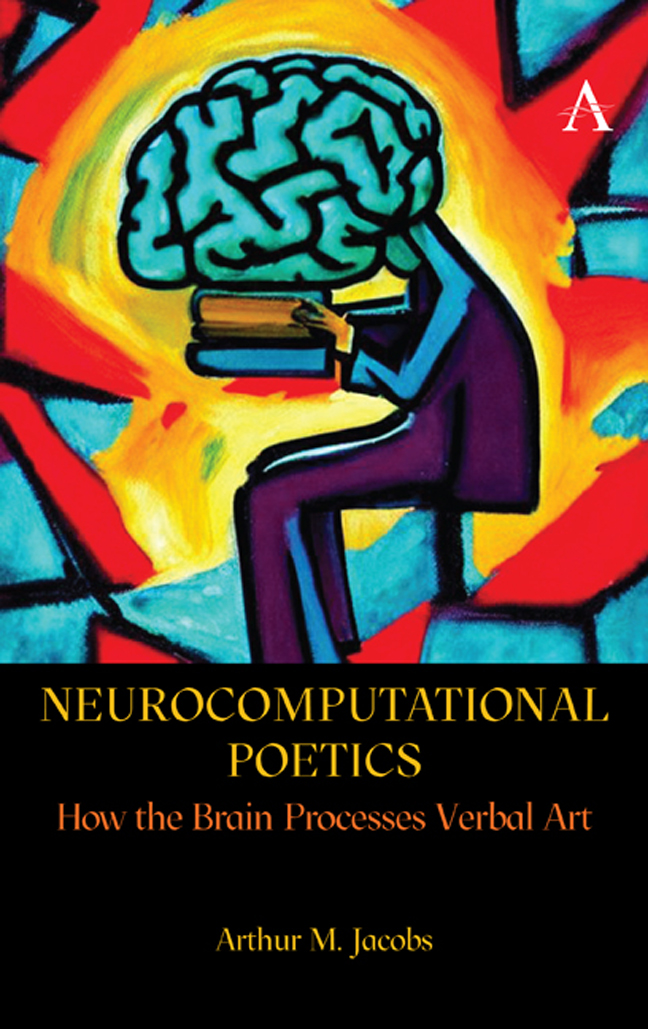Book contents
- Frontmatter
- Contents
- Acknowledgements
- Dedication
- Preface
- 1 Introduction: The Two Boons of an Unnatural Daily Activity
- 2 Models and Methods
- 3 Text Analysis
- 4 Reader and Reading Act Analysis
- 5 Computational Poetics I: Simple Applications
- 6 Computational Poetics II: Sophisticated Applications
- 7 Neurocomputational Poetics I: Upper Route Studies
- 8 Neurocomputational Poetics II: Lower Route Studies
- 9 Conclusions
- References
- Index
8 - Neurocomputational Poetics II: Lower Route Studies
Published online by Cambridge University Press: 01 March 2024
- Frontmatter
- Contents
- Acknowledgements
- Dedication
- Preface
- 1 Introduction: The Two Boons of an Unnatural Daily Activity
- 2 Models and Methods
- 3 Text Analysis
- 4 Reader and Reading Act Analysis
- 5 Computational Poetics I: Simple Applications
- 6 Computational Poetics II: Sophisticated Applications
- 7 Neurocomputational Poetics I: Upper Route Studies
- 8 Neurocomputational Poetics II: Lower Route Studies
- 9 Conclusions
- References
- Index
Summary
In this section, my focus is on studies that informed us about the workings of the lower route of the NCPM and the second boon of reading: affective-aesthetic processes. For the sake of clarity and simplicity, I divided the section into studies dealing mainly with effects of sound and those investigating effects of semantics, knowing all too well that sound and meaning are not as independent as has been assumed. The first study serves as an introduction on the role of syllables, shedding light on the internal structure of syllables. The remaining ‘sound’ studies then directly speak to affective-aesthetic processes. The first three semantic studies concern the affective-aesthetic processing of single words, followed by two studies looking at cognitive-affective effects in meaning making for multiword expressions (literal and metaphoric compounds and idioms). The last study examines affective-aesthetic effects in proverbs and anti-proverbs.
The Sound Studies
Music and language can be seen as forms of sound that are meaningful within a society and can express a certain degree of intentionality, that is, they can represent or stand for things or states of affairs. As a hobby musician and great fan of both the music and lyrics of jazz standards like ‘As Time Goes By’ or ‘Autumn Leaves’ – whose original text was written by one of my favourite French poets, Jaques Prévert – I was always interested in how the two play together to create stronger emotions than each on its own. In both media, the sound material is split up into two sections, pitch and rhythm, its continuum being divided into notes on the one side and syllables on the other. Music combines its tones to chords to arrange them into a syntagma of time units such as rhythm, tempo and beat. Similarly, language combines syllables into words to arrange them into a syntax with its own time units: stress or accents, lengths, shortenings and breaks. So, if the syllables are so important, where do they come from? The next paragraph gives us a tentative answer to that question.
Phonemic Jargon Aphasia or Why Mr. Tan Had a Secret Preferred Syllable
Imagine you wake up in the morning, see your wife and want to say some nice words to her. But then, only the monosyllable ‘tan’ comes out of your mouth.
Information
- Type
- Chapter
- Information
- Neurocomputational PoeticsHow the Brain Processes Verbal Art, pp. 191 - 232Publisher: Anthem PressPrint publication year: 2023
